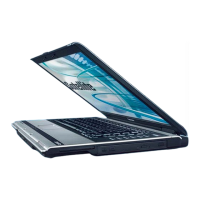
Do you have a question about the Toshiba Satellite A30 Series and is the answer not in the manual?
Guidelines for safe operation, avoiding heat and electrical hazards.
Safety precautions for optical drives and laser system classification.
Details the classification label and compliance with laser product standards.
Warning about lead exposure from AC adaptor cord and hand washing.
Advice on preventing stress injuries from keyboard use and workspace design.
Precautions against heat-related injuries from computer and AC adapter.
Warning against applying excessive pressure or impact to the computer.
Specifies approved environments like residential, commercial, and light industry.
Lists unapproved environments like industrial, medical, automotive, and aircraft.
Emphasizes reading and understanding safety instructions before using wireless products.
Lists equipment not to be controlled by wireless products for safety reasons.
Warnings about using wireless products near pacemakers, medical equipment, and aircraft.
Lists hardware and software items included with the computer.
Details the physical components of the Satellite A30 Series computer.
Lists the software preinstalled on the computer's hard disk.
Lists the various documents provided with the computer for user reference.
Explains automatic system entry into Hibernation or Standby modes.
Identifies components on the computer's front when the display is closed.
Explains the meaning of various system indicator lights on the computer.
Locates and describes the computer's built-in speakers.
Lists the various DVD and CD formats supported by the drive.
Explains DVD region codes and their importance for media compatibility.
Details the AC adaptor's function in converting power and its voltage compatibility.
Provides guidance on creating a comfortable and safe work environment.
Step-by-step instructions for connecting the AC adaptor to the computer.
Guidance on how to open and adjust the computer's display panel.
Instructions on how to power on the computer for the first time or subsequent uses.
Describes the process of starting the computer for the very first time.
Explains different methods for shutting down or powering off the computer.
Specifies optimal temperature, humidity, and ventilation for computer operation.
Advice on positioning the computer for comfort, safety, and visibility.
Guidelines for ergonomic seating and posture to reduce work strain.
Recommendations for lighting to improve display legibility and reduce eye strain.
Tips on varying posture, stretching, and taking frequent short breaks.
Advice on eye care and regular checks for fan inlets and exhaust vents.
Step-by-step guide to connect the AC adaptor for power and battery charging.
Instructions on how to open the display panel and adjust viewing angle.
Details the steps to press and hold the power button to turn on the computer.
Describes the process of starting the computer for the very first time.
Describes how to properly shut down the computer and save data.
Details the hibernation feature for saving memory state when powered off.
Explains how data is saved to HDD during hibernation mode.
Describes the standby mode where the system remains on but in sleep.
Lists precautions before entering standby mode, like saving data.
Highlights advantages of standby mode, like faster restoration and power saving.
Provides methods to enter standby mode via Start menu or panel actions.
Lists conditions under which standby mode may not function correctly.
Outlines methods for resetting or restarting the computer.
Details how to restore the operating system from recovery media.
Guide on using the touch pad for controlling the on-screen pointer.
Essential safety measures when operating DVD/CD drives.
Step-by-step instructions for loading DVD/CD discs into the drive.
Instructions on safely removing DVD/CD discs from the drive.
Recommendations for media manufacturers and preparation before writing.
Instructions on making settings and connecting the internal modem.
Safety precautions when using telephone equipment, including water and storms.
Step-by-step guide to connect the internal modem to a telephone line.
Instructions on how to safely disconnect the internal modem cable.
Procedures for connecting the computer to a Local Area Network (LAN).
Details Wireless LAN compatibility with IEEE 802.11 standards and features.
Explains how to enable/disable wireless LAN using the on/off switch.
Explains the basic functions of typewriter keys and differences from a typewriter.
Using hotkeys for sound mute and instant screen security.
Hotkeys for changing power save modes and entering standby.
Using the Fn+F4 hotkey to enter hibernation mode.
Explains how power conditions affect operation and status indicators.
Important advisories on handling batteries to prevent injury or damage.
Lists critical dangers associated with battery misuse, heat, and short-circuiting.
Warnings about contact with caustic electrolyte fluid from batteries.
Cautions regarding continued use of impaired batteries and proper disposal.
Detailed instructions for safely removing the computer's battery pack.
Detailed instructions for safely installing a new or spare battery pack.
How to configure automatic power off/on when closing/opening the display panel.
Step-by-step guide for installing a PC card into the computer.
Instructions on safely removing a PC card using the Task Bar icon.
General guidelines for effectively troubleshooting computer issues.
Steps to take before seeking technical assistance, like reviewing documentation.
Information on contacting TOSHIBA in writing or via their website for hardware issues.










